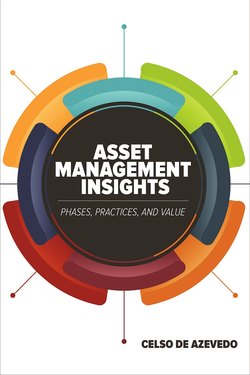Читать книгу Asset Management Insights - Celso de Azevedo - Страница 7
На сайте Литреса книга снята с продажи.
ОглавлениеPreface
Celso de Azevedo has a reputation in the field of Asset Management that always precedes him. I had the privilege of meeting Celso for the first time at the inaugural meeting of ISO/PC251 (Asset Management) in Melbourne, Australia in 2010. When I met him and engaged with him, I quickly learned that everything about his reputation was true. A man with a heritage spanning Brazil and France, bringing the passion we expect from those cultures to all things Asset Management in a larger-than-life way, but merged with a vast experience and ability to analyze and learn.
In our ongoing work on Asset Management in ISO/TC251 (we changed from a Project Committee to a Technical Committee with a wider scope in 2015) our focus is on helping organizations deliver “value.” For many people, the word “value” is interpreted as a financial value only, but we live in a complex world with complex stakeholder groups, each with competing demands and competing definitions of what “value” means to them. That value may be financial but it may also be safety, or environmental or ambience or reliability or a myriad of other tangible and intangible benefits depending upon the respective viewpoints of those stakeholder groups. Pleasingly, the core of this book is “value” and how it is overlaid across the asset life cycles and how it relates to costs.
This is a nice approach because in our organizational worlds, we may only have a single window through which to view one part of the asset life cycle, so for all readers there will be at least one section of the book with which they are familiar. The remainder of the sections are areas with which they should be familiar, and this is the Asset Management paradigm. Namely, we must have an understanding of all life cycle phases and all organizational functions even when our own function and window on a specific life cycle phase may be dominating our daily thoughts.
If this is not complex enough, Asset Management is a young discipline with many evangelists claiming to know the one true way! This leaves any author with a dilemma on how to balance the need to communicate a new discipline in an authoritative way to those who want to learn, while at the same time, hypothesizing and exploring how the discipline will grow. All of this needs to be achieved without appearing to shout from an ivory tower. No simple task at all!
Celso has written this book in a way that enables us to explore Asset Management thinking throughout the life cycle of the assets but with a focus on value (both tangible and intangible), recognizing the importance of cost and how we express intangible value through the measurement of monetized risk. He does not claim to have that singular truth of how to solve all Asset Management problems but instead presents his perspective on those problems through his extensive experience both from infrastructure and industrial scenarios around the globe. He presents theories for solutions, not in a mandatory way, but more in the approach of the traditional scientific method. By this I mean that this book is an invitation to challenge and test his theory through our own experience and application. This addresses, I believe, the problem of the evangelist author and his singular truth.
What of the problem of writing about complex organizations and complex asset life cycles? Inevitably in writing a sequential book it is required that the text be divided into chapters. Some readers will be drawn to individual sections to learn or even to challenge. Others will read the whole book from front to back. I am sure Celso would invite us to learn and become expert in each of the areas explored but having known him for many years, I am also sure that he would advocate total adoption of all of the thinking to some extent. For me, this reflects the complex nature of Asset Management, where we need a broad view of context and the ability to apply analytical approaches in great detail into that broad context.
In another potential life where Celso de Azevedo was perhaps Dutch and not Brazilian/French, he may have termed it Total Asset Management like the great Dutch soccer teams of the 1970s. In Total Football, a player who moves out of his position is replaced by another from his team, thus retaining the team’s intended organizational purpose and approach. I feel there is much of this book that reflects this thinking and I hope that you enjoy it, learn from it, test it, and challenge it to deliver greater value for your organization’s stakeholders.
Rhys Davies
Chair of ISO/TC251—Asset Management
